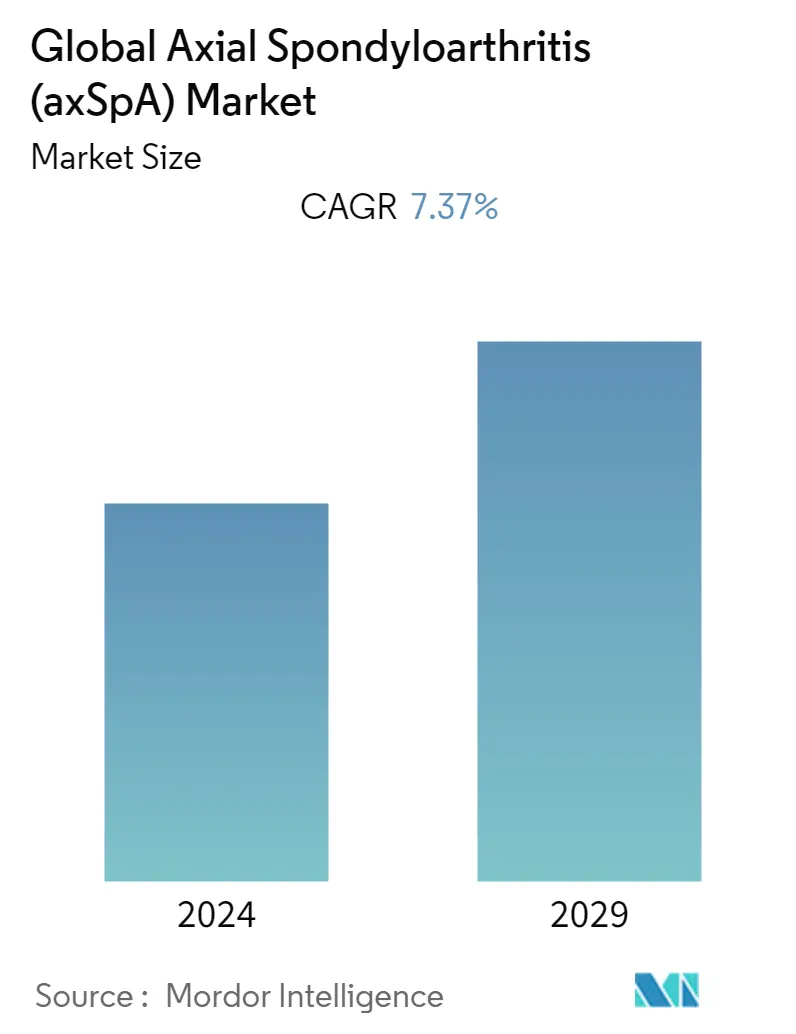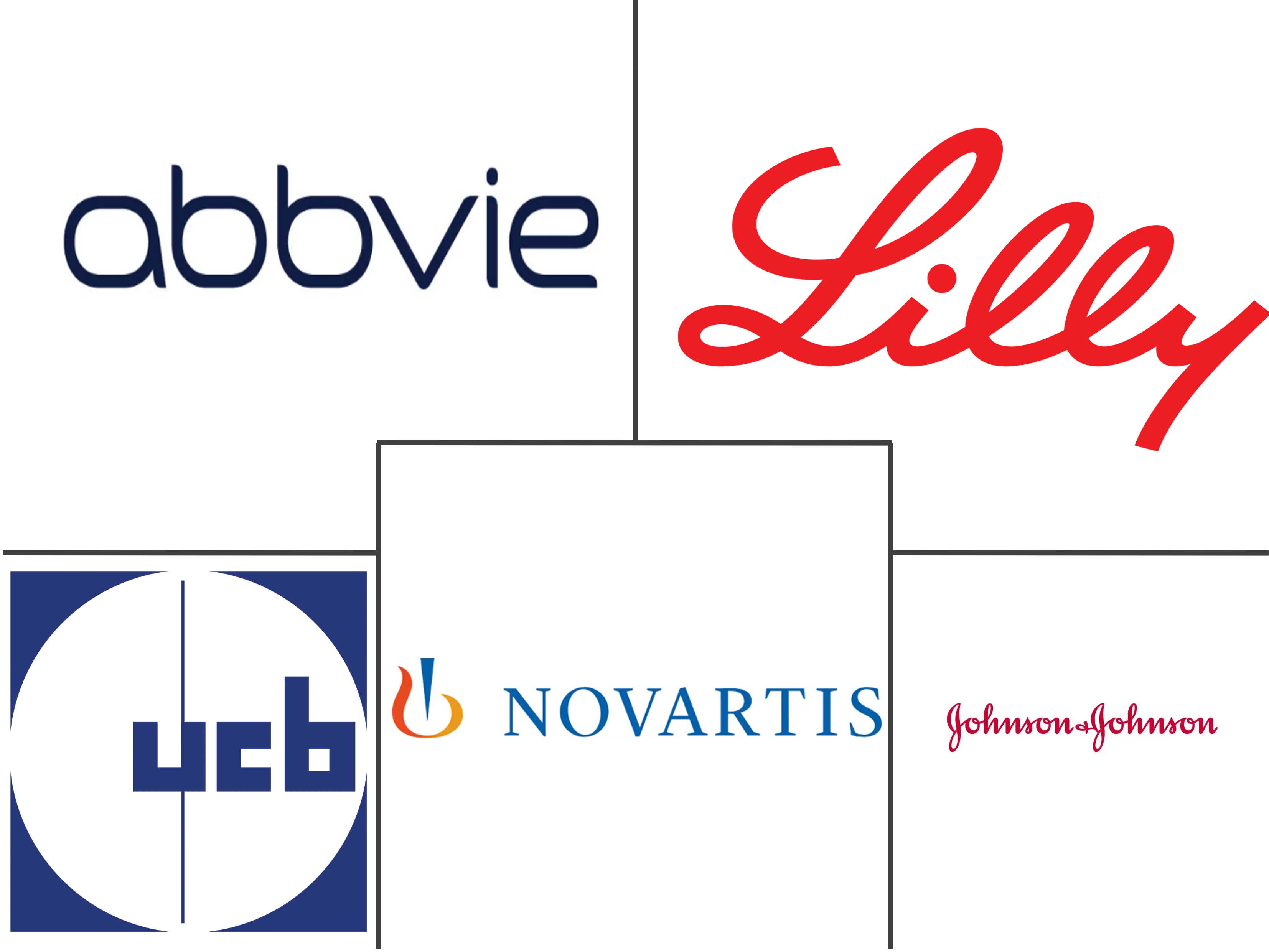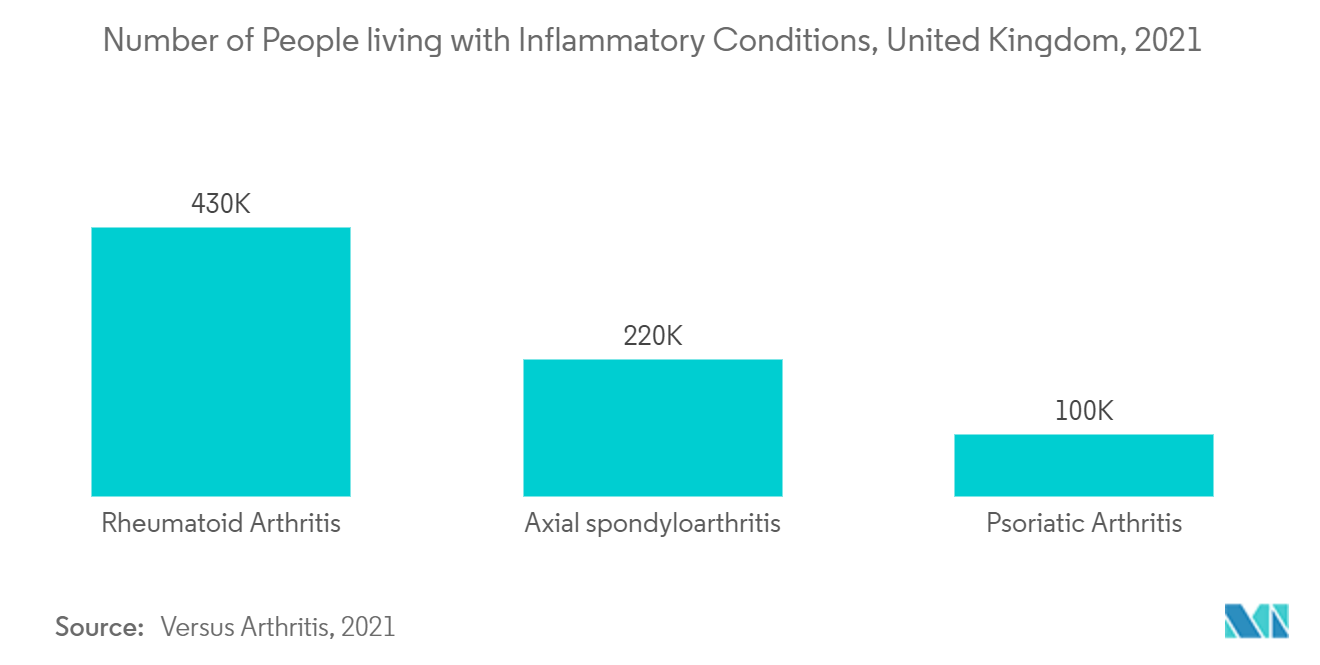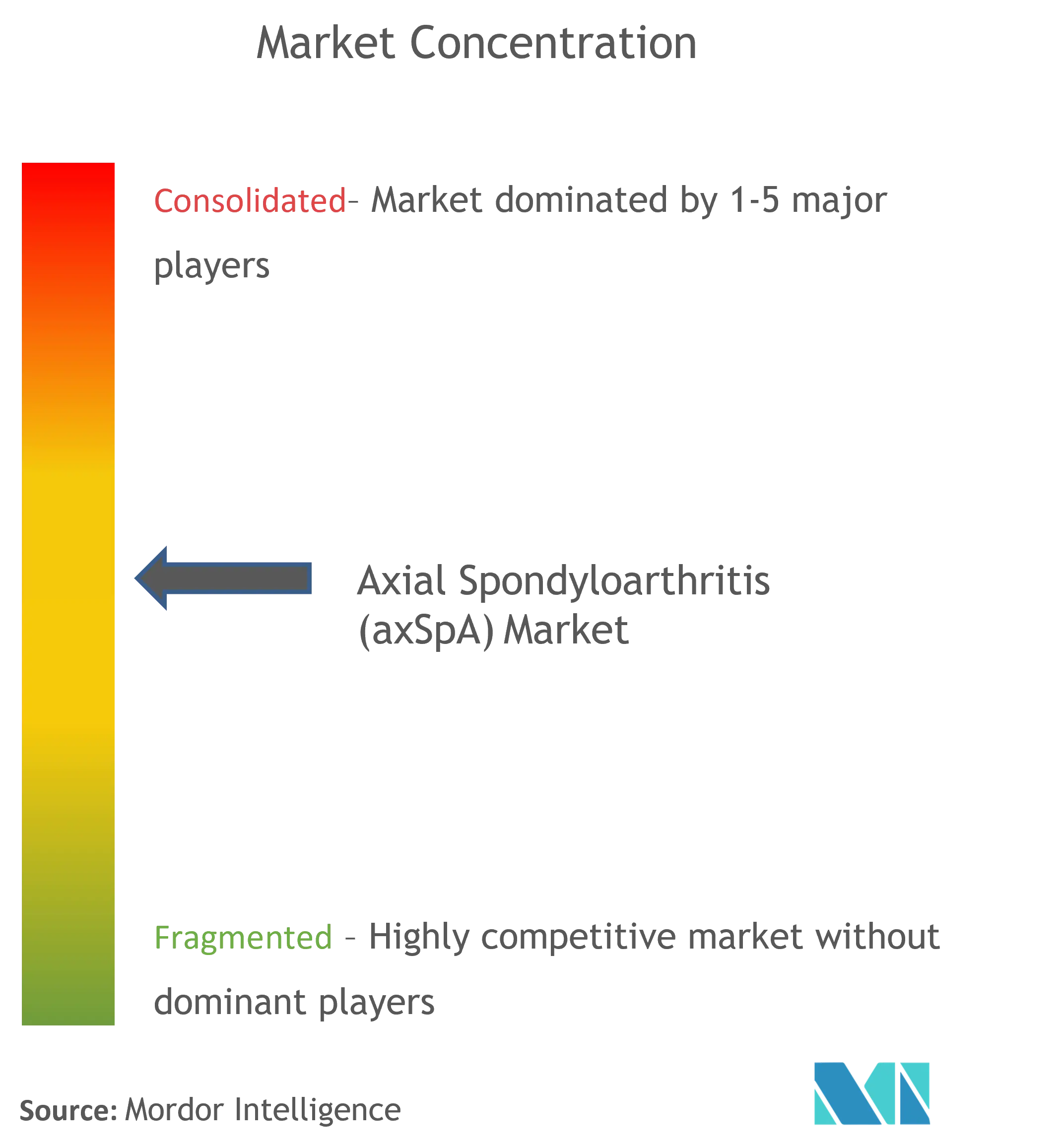Axial Spondyloarthritis (axSpA) Market Size

| Study Period | 2019 - 2029 |
| Base Year For Estimation | 2023 |
| Forecast Data Period | 2024 - 2029 |
| CAGR | 7.37 % |
| Fastest Growing Market | Asia-Pacific |
| Largest Market | North America |
Major Players
*Disclaimer: Major Players sorted in no particular order |
Axial Spondyloarthritis (axSpA) Market Analysis
The Axial Spondyloarthritis market is projected to register a CAGR of 7.37% during the forecast period (2022-2027).
With the increasing COVID-19 cases worldwide, healthcare services diverted all resources toward patients suffering from COVID-19 disease. Although COVID-19 severely affects the respiratory system, it has created multiple uncertainties regarding rheumatic diseases or their treatment about the susceptibility to or severity of the viral disease. The COVID-19 pandemic has been especially challenging for patients with inflammatory diseases, including spondyloarthritis (SpA). Although numerous studies have addressed how a COVID-19 infection affects patients with rheumatic diseases, the conclusions from these reports have not been consistent. A study published in The Journal of Rheumatology in 2022 captured responses from 4723 subjects with SpA and 450 household contacts of these subjects showed that the COVID-19 pandemic created multiple uncertainties regarding rheumatic diseases or their treatment with regard to the susceptibility or severity of the viral disease.
There has been increased research and development going on for rheumatic diseases during the pandemic. For instance, in February 2021, EULAR, the European Alliance of Associations for Rheumatology, launched COVAX. This is a doctor-reported registry to collect information about COVID vaccination in people with both inflammatory and non-inflammatory rheumatic and musculoskeletal diseases (RMDs).
Certain factors that are driving the market growth include improvements in awareness which result in the increased patient pool that proves to be positive upfront for the Axial spondyloarthritis market and helps patients to try new interventions. There are several governmental and non-governmental organizations coming up to raise awareness among the general population about the condition. There are several initiatives taking place to advocate for people about the diagnosis and treatment of the same. Some of the initiatives include Rheumatoid Arthritis Awareness Day, supported by groups such as Arthritis National Research Foundation, which is held in February each year. In addition to this, Rheumatic Disease Awareness Month (RDAM) is held in September in the United States. As a result of increased awareness, people are aware of the diagnosis, and hence, the overall market will boost in the forecasted period.
Additionally, as part of the Bone and Joint Week celebration in October 2021, Novartis announced the renewal of its partnership with the Axial Spondyloarthritis Association of the Philippines (ASAPh) and Philippine Rheumatology Association (PRA) to raise awareness of Axial Spondyloarthritis (axSpA) early diagnosis and treatment.
The advent of biologic drugs has transformed the management of patients with axial spondyloarthritis. An increase in biologics is another factor that can drive the market. As per the American College of Rheumatology, Non-steroidal anti-inflammatory drugs (commonly called NSAIDs) offer symptom relief for most patients by reducing pain and swelling. Other medicines called biologics, including anti-TNF drugs (TNF blockers) and anti-IL-17 drugs (IL-17 blockers), are effective in patients who do not respond well enough to NSAIDs. The first lines of treatment are the NSAIDs, such as naproxen, ibuprofen, meloxicam, or indomethacin. Biologic medicines are manufactured within a living system, and target specific molecules believed to be involved in axial SpA. They are made up of genetically engineered proteins and are very large, complex molecules. The National Institute for Health and Care Excellence (NICE) has produced written national guidelines about prescribing anti-TNF therapy and anti-IL-17A that must be followed.
In addition to this, until very recently, there were five licensed anti-TNF drugs (adalimumab, certolizumab, etanercept, golimumab, and infliximab) for the indication of ankylosing spondylitis and four (adalimumab, etanercept, certolizumab, and golimumab) for the indication of Non-Radiographic Axial Spondyloarthritis (in the United States, only certolizumab was approved for the indication of Non-Radiographic Axial Spondyloarthritis). The IL-17 blocker secukinumab has been approved by both the European Medicines Agency (EMA) and the United States Food and Drug Administration (FDA) for the indication of ankylosing spondylitis. Ixekizumab was initially (2019) approved by the FDA for ankylosing spondylitis, and in July 2020, the FDA expanded the approval of ixekizumab to include Non-Radiographic Axial Spondyloarthritis; almost simultaneously, the EMA also approved ixekizumab for the treatment of both ankylosing spondylitis and Non-Radiographic Axial Spondyloarthritis.
Thus, owing to the abovementioned factors, the market is expected to show growth over the forecast period. However, severe adverse effects of certain therapeutic drugs significantly hinder the market's growth.
Axial Spondyloarthritis (axSpA) Market Trends
This section covers the major market trends shaping the Axial Spondyloarthritis (axSpA) Market according to our research experts:
The Non-steroidal Anti Inflammatory Drug Class Segment is Expected to Hold a Major Market Share in the Studied Period
The nonsteroidal anti-inflammatory drug class Segment occupies a major share of the market over the forecast period. Nonsteroidal anti-inflammatory drugs (NSAIDs) are highly effective and most commonly used in the treatment of axial spondyloarthritis.
Treatment for axSpA usually starts with nonsteroidal anti-inflammatory drugs (NSAIDs). Nonsteroidal anti-inflammatory drugs (NSAIDs) are highly effective against the major symptoms of axSpA (pain and stiffness) and may have disease-modifying properties, including retarding the progression of structural damage in the spine. Therefore, NSAIDs, unless contraindicated, are the treatment of choice for the majority of patients with axSpA. Nonsteroidal anti-inflammatory drugs (NSAIDs), such as naproxen (Naprosyn) and indomethacin (Indocin and Tivorbex), are the medications preferred by doctors.
Furthermore, new product launches are likely to fuel the treatment market, as they are used as the first line of treatment. For instance, in July 2022, RINVOQ (upadacitinib) was approved by European Commission as an oral treatment for adults with active non-radiographic axial spondyloarthritis.
Thus, the segment is anticipated to witness significant growth over the forecast period due to the abovementioned factors.

North America Holds a Significant Share and is Expected to Follow the Same Trend Over the Forecast Period
North America is expected to hold a significant market share in the global Axial spondyloarthritis market due to a rise in awareness, increasing prevalence in this region, and improved diagnosis. The United States is the most affected country across the world, as there are higher numbers of patients suffering from Axial spondyloarthritis and higher in the North America region as the patient population is increasing compared to other countries.
North America is expected to hold a significant market share in the global Axial spondyloarthritis market due to a rise in awareness, increasing prevalence in this region, and improved diagnosis. As per a study published in The American Journal of Managed Care (AJMC) in January 2020 titled ''Understanding Axial Spondyloarthritis: A Primer for Managed Care, approximately 1.5 million Americans are affected by axial spondyloarthritis, with estimates of axial spondyloarthritis prevalence ranging from 0.9% to 1.4%. Typically, axial spondyloarthritis affects the younger spondyloarthritis patient population, with an average age of symptom onset of 28 years. Additionally, as per the study published in July 2021 titled 'Investigating Diagnosis, Treatment, and Burden of Disease in Patients with Ankylosing Spondylitis in Central Eastern Europe and the United States: A Real-World Study, the prevalence of ankylosing spondylitis ranged from 9 to 30 per 10,000 persons, which is lower than previous estimates. The progression of patients with non-radiographic axial spondyloarthritis to ankylosing spondylitis is slow, with forecasts of 5.1% in 5 years and 19% in 10 years.
Moreover, high expenditure on healthcare, especially in the United States and Canada, and increased awareness about the disease are fueling the growth of the overall regional market to a large extent.

Axial Spondyloarthritis (axSpA) Industry Overview
The axial spondyloarthritis market is fragmented, competitive, and consists of several major players. In terms of market share, a few of the major players are currently dominating the market. Some of the companies which are currently dominating the market are Johnson & Johnson, UCB, Amgen, Novartis Pharmaceuticals Corporation, Eli Lilly and Company, Kyowa Kirin, AbbVie, Acelyrin, and Pfizer.
Axial Spondyloarthritis (axSpA) Market Leaders
-
Janssen Biotech
-
AbbVie
-
UCB
-
Amgen
-
Novartis Pharmaceuticals Corporation
*Disclaimer: Major Players sorted in no particular order

Axial Spondyloarthritis (axSpA) Market News
- In April 2022, Ampersand Health and UCB announced a partnership to help patients with Axial Spondyloarthritis (axSpA). The two companies will be supporting Project Nightingale, an ongoing study run by the Royal National Hospital for Rheumatic Diseases (RNHRD) in Bath. The project is designed to assist axSpA patients in managing their symptoms and improving their quality of life.
- In March 2022, Ixekizumab demonstrated efficacy in reducing or preventing the progression of radiographic axial spondyloarthritis (r-axSpA) over a 2-year treatment period, according to study results published in the Journal of Rheumatology.
Axial Spondyloarthritis (axSpA) Market Report - Table of Contents
1. INTRODUCTION
- 1.1 Study Assumptions and Market Definition
- 1.2 Scope of the Study
2. RESEARCH METHODOLOGY
3. EXECUTIVE SUMMARY
4. MARKET DYNAMICS
- 4.1 Market Overview
-
4.2 Market Drivers
- 4.2.1 Improvements in awareness and increasing patient pool
- 4.2.2 Advancements of biologica and New therapeutic options in the pipeline
-
4.3 Market Restraints
- 4.3.1 Delayed Diagnosis and High cost involved in treatment
-
4.4 Porter's Five Forces Analysis
- 4.4.1 Threat of New Entrants
- 4.4.2 Bargaining Power of Buyers/Consumers
- 4.4.3 Bargaining Power of Suppliers
- 4.4.4 Threat of Substitute Products
- 4.4.5 Intensity of Competitive Rivalry
5. MARKET SEGMENTATION (Market Size by Value - USD million)
-
5.1 By Types
- 5.1.1 Ankylosing spondylitis (AS)
- 5.1.2 Non-radiographic axial spondyloarthritis (nr-axSpA)
-
5.2 By Drug class
- 5.2.1 Non-steroidal anti-inflammatory drugs (NSAID)
- 5.2.2 Glucocorticoids
- 5.2.3 Anti-rheumatic drugs
- 5.2.4 Others
-
5.3 Geography
- 5.3.1 North America
- 5.3.1.1 United States
- 5.3.1.2 Canada
- 5.3.1.3 Mexico
- 5.3.2 Europe
- 5.3.2.1 Germany
- 5.3.2.2 United Kingdom
- 5.3.2.3 France
- 5.3.2.4 Italy
- 5.3.2.5 Spain
- 5.3.2.6 Rest of Europe
- 5.3.3 Asia-Pacific
- 5.3.3.1 China
- 5.3.3.2 Japan
- 5.3.3.3 India
- 5.3.3.4 Australia
- 5.3.3.5 South Korea
- 5.3.3.6 Rest of Asia-Pacific
- 5.3.4 Middle-East and Africa
- 5.3.4.1 GCC
- 5.3.4.2 South Africa
- 5.3.4.3 Rest of Middle-East and Africa
- 5.3.5 South America
- 5.3.5.1 Brazil
- 5.3.5.2 Argentina
- 5.3.5.3 Rest of South America
6. COMPETITIVE LANDSCAPE
-
6.1 Company Profiles
- 6.1.1 Johnson and Johnson
- 6.1.2 AbbVie
- 6.1.3 Amgen
- 6.1.4 Novartis Pharmaceuticals Corporation
- 6.1.5 Eli Lilly and Company
- 6.1.6 UCB
- 6.1.7 Kyowa Kirin
- 6.1.8 AbbVie
- 6.1.9 Acelyrin
- 6.1.10 Pfizer
- *List Not Exhaustive
7. MARKET OPPORTUNITIES AND FUTURE TRENDS
** Subject To AvailablityAxial Spondyloarthritis (axSpA) Industry Segmentation
As per the scope of this report, Axial spondyloarthritis (axSpA) is a chronic inflammatory rheumatic disease that primarily affects the sacroiliac joints and spine and commonly presents in patients aged < 40 years with inflammatory back pain (IBP) as a presenting symptom. The axial Spondyloarthritis (axSpA) market is segmented by Types (Ankylosing spondylitis (AS) and Non-radiographic axial spondyloarthritis (nr-axSpA)), By Drug Class (Non-steroidal anti-inflammatory drugs (NSAID), Glucocorticoids, Anti-rheumatic drugs, and Others), and Geography (North America, Europe, Asia-Pacific, Middle-East and Africa, and South America). The report offers the value (in USD million) for the above segments.
| By Types | Ankylosing spondylitis (AS) | |
| Non-radiographic axial spondyloarthritis (nr-axSpA) | ||
| By Drug class | Non-steroidal anti-inflammatory drugs (NSAID) | |
| Glucocorticoids | ||
| Anti-rheumatic drugs | ||
| Others | ||
| Geography | North America | United States |
| Canada | ||
| Mexico | ||
| Geography | Europe | Germany |
| United Kingdom | ||
| France | ||
| Italy | ||
| Spain | ||
| Rest of Europe | ||
| Geography | Asia-Pacific | China |
| Japan | ||
| India | ||
| Australia | ||
| South Korea | ||
| Rest of Asia-Pacific | ||
| Geography | Middle-East and Africa | GCC |
| South Africa | ||
| Rest of Middle-East and Africa | ||
| Geography | South America | Brazil |
| Argentina | ||
| Rest of South America |
Axial Spondyloarthritis (axSpA) Market Research FAQs
What is the current Global Axial Spondyloarthritis (axSpA) Market size?
The Global Axial Spondyloarthritis (axSpA) Market is projected to register a CAGR of 7.37% during the forecast period (2024-2029)
Who are the key players in Global Axial Spondyloarthritis (axSpA) Market?
Janssen Biotech, AbbVie, UCB, Amgen and Novartis Pharmaceuticals Corporation are the major companies operating in the Global Axial Spondyloarthritis (axSpA) Market.
Which is the fastest growing region in Global Axial Spondyloarthritis (axSpA) Market?
Asia-Pacific is estimated to grow at the highest CAGR over the forecast period (2024-2029).
Which region has the biggest share in Global Axial Spondyloarthritis (axSpA) Market?
In 2024, the North America accounts for the largest market share in Global Axial Spondyloarthritis (axSpA) Market.
What years does this Global Axial Spondyloarthritis (axSpA) Market cover?
The report covers the Global Axial Spondyloarthritis (axSpA) Market historical market size for years: 2019, 2020, 2021, 2022 and 2023. The report also forecasts the Global Axial Spondyloarthritis (axSpA) Market size for years: 2024, 2025, 2026, 2027, 2028 and 2029.
Global Axial Spondyloarthritis (axSpA) Industry Report
Statistics for the 2024 Global Axial Spondyloarthritis (axSpA) market share, size and revenue growth rate, created by Mordor Intelligence™ Industry Reports. Global Axial Spondyloarthritis (axSpA) analysis includes a market forecast outlook to 2029 and historical overview. Get a sample of this industry analysis as a free report PDF download.



